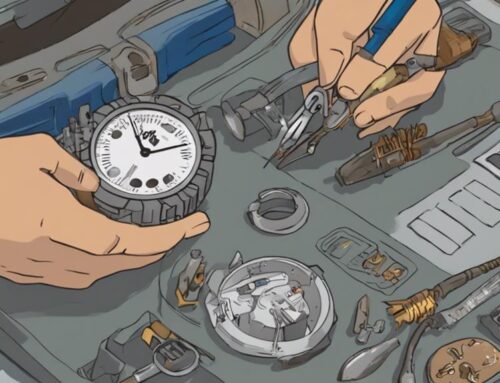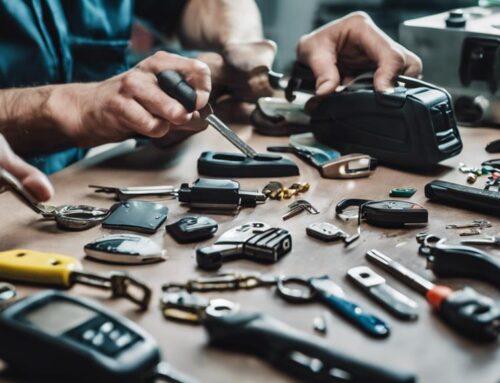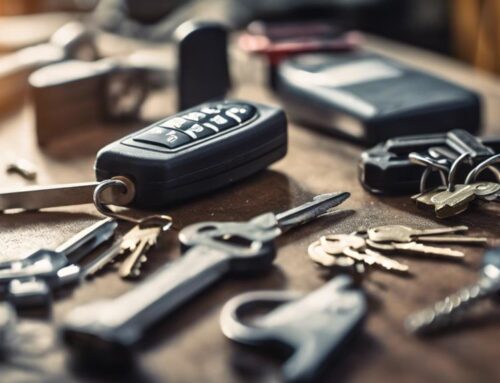Losing a transponder key can feel like misplacing the compass that guides you through the maze of daily life. First, you need to assess the situation—identify the key type and check for any visible damage in your ignition system. You might find it helpful to retrace your steps, but what if it's not just lost? Understanding your options, from contacting a dealership to contemplating a locksmith, could save you time and frustration. Let's explore the best steps you can take to regain control and prevent this from happening again.
Key Takeaways
- Assess the situation by identifying the key type and checking for damage to the ignition system or the key itself.
- Search for the lost key by retracing your steps and checking common areas where it might be misplaced.
- Inspect the key for physical damage and test the battery functionality to ensure it is working properly.
- Contact your dealership or a locksmith for replacement or reprogramming options tailored to your vehicle's needs.
- Prevent future issues by conducting regular battery checks, using protective cases, and programming backup keys.
Assess the Situation

When you realize your transponder key is lost, damaged, or simply not working, the first step is to assess the situation carefully. Identify key types relevant to your vehicle; understanding whether you have a chip key or a smart key is vital. Check for any visible damage or malfunction in the ignition system, as this could exacerbate the issue. If you have a spare, test it to determine if the problem lies with the primary key. Consider your emergency options; you might need to contact a locksmith or your vehicle's manufacturer for assistance. Document any attempts to resolve the issue, as this information can aid professionals in diagnosing the problem efficiently. Taking swift, informed action is essential to regain control over your vehicle's access.
Search for the Key
Many vehicle owners often overlook simple places where a transponder key might be hiding. Start by implementing effective search strategies. Check common areas like your pockets, bags, and car compartments. Look under seats, in between cushions, or inside the center console. Consider retracing your steps to the last known location of your lost key. If you were at a friend's house or a public space, inquire if anyone has seen it. Utilize a flashlight for dark spaces, ensuring you don't miss any hidden corners. If the key remains elusive, think about places where you may have absentmindedly placed it, like the kitchen counter or your office desk. This methodical approach can save you time and stress in locating your lost key. Remember, locksmiths can often program transponder keys without the originals if needed.
Determine the Damage
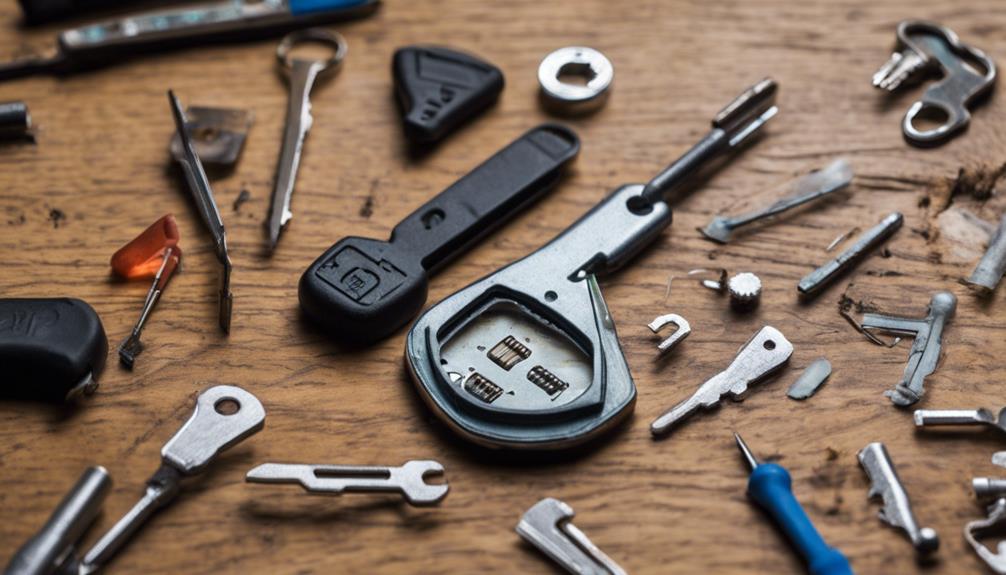
To determine the damage to your transponder key, start with a thorough visual inspection to identify any obvious cracks or wear. Next, check the battery functionality to guarantee it's providing adequate power. Finally, test the key's signal strength to see if it's transmitting properly to your vehicle's system.
Visual Inspection Process
Before diving into solutions for your transponder key issues, it's crucial to conduct a thorough visual inspection. Start by examining the key's physical condition. Look for cracks, chips, or signs of wear that could affect the transponder technology embedded within. Check the key's casing for any misalignment that may disrupt its function. Verify the key blade isn't bent or damaged, as this can compromise key security. Pay close attention to the transponder chip area; any visible damage here can prevent proper communication with your vehicle's ignition system. Additionally, understanding the common problems that occur with transponder keys and how to avoid reprogramming them frequently can help prevent key system issues. By meticulously evaluating these components, you can identify potential issues before seeking repair or replacement, guaranteeing you maintain the power and reliability of your key system.
Check Battery Functionality
Regularly checking the battery functionality of your transponder key is essential for ensuring it operates correctly. A weak or dead key battery can prevent your vehicle from recognizing the key, leading to frustration and inconvenience. To determine if the battery needs replacement, first, inspect the key for any visible signs of damage. If it appears intact but is unresponsive, it's time to test the battery. You can use a multimeter to check the voltage output; a voltage considerably below the manufacturer's specifications indicates a need for battery replacement. Always opt for high-quality batteries that match your key's requirements to maintain peak performance. Taking these proactive steps will empower you to address potential issues before they escalate. Additionally, understanding the process of key fob programming, as outlined in Unlocking the Process: Key Fob Programming Explained, can provide valuable insights into troubleshooting and resolving key-related problems.
Test Key Signal Strength
Testing the key signal strength is essential for diagnosing potential issues with your transponder key. Begin by evaluating whether there's any signal interference affecting communication between the key and your vehicle's ignition system. Use a multimeter to measure the key's output signal; a weak signal could indicate a damaged chip or internal circuitry failure. If you notice consistent signal drops, consider environmental factors that may contribute to interference. Understanding transponder technology helps you pinpoint these weaknesses. If the signal remains strong, the key might be functioning properly, and you should explore other potential issues, such as the ignition system itself. Ultimately, accurate signal testing empowers you to take decisive action in restoring your transponder key's functionality.
Contact Your Dealership
When dealing with transponder key issues, contacting your dealership is essential. You'll need to verify your key type and provide specific vehicle information to guarantee accurate assistance. Don't forget to inquire about your replacement options to get back on the road quickly.
Verify Key Type
To resolve issues with your transponder key, it is essential to verify the key type by contacting your dealership. Your dealership can confirm the specific key compatibility required for your vehicle model. This step is important, as different vehicles utilize varying transponder technology, which can affect your key's functionality. Provide your dealership with any details about your vehicle, such as the make, model, and year. They'll guide you in identifying whether you need a standard key, a high-security key, or a smart key. Knowing the exact key type guarantees that you don't waste time or resources on the wrong replacement. It also prevents potential security breaches associated with incompatible keys. Take charge and get it right the first time.
Provide Vehicle Information
Providing accurate vehicle information is vital when contacting your dealership for transponder key assistance. You'll need to provide your vehicle make and vehicle model to guarantee they can help you efficiently. For instance, if you drive a Ford F-150, specify this detail upfront. This information allows the dealership to access the correct database, which is critical for identifying the right key type and programming requirements. Be prepared to share your vehicle identification number (VIN), as this can expedite the process. Accurate details not only save time but also enhance the effectiveness of the support you receive. When contacting your dealership, precision in your vehicle information can greatly influence the resolution of your transponder key issue.
Inquire About Replacement Options
After you've gathered your vehicle information, it's essential to reach out to your dealership to inquire about replacement options for your transponder key. Dealerships typically offer various transponder key types, including basic, high-security, and smart keys. Each type comes with different functionalities and security features, affecting replacement costs.
When you contact your dealership, be prepared to discuss your vehicle's make, model, and year, as these specifics determine the appropriate key replacement. Ask for detailed pricing on each transponder key type, as costs can vary considerably. Some dealerships may also provide information on programming fees and any additional services, ensuring you have a thorough understanding of your replacement options.
Call a Locksmith
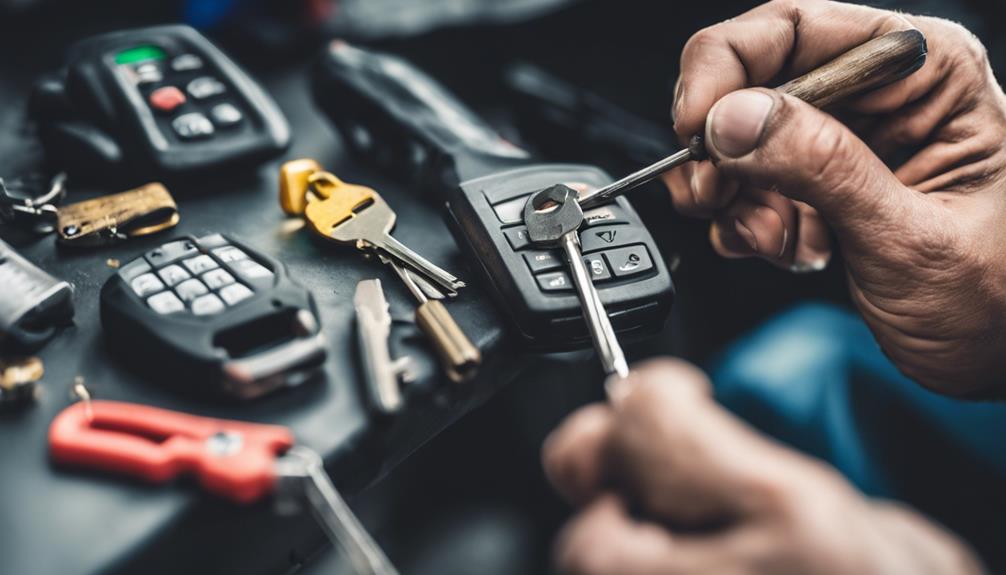
When you're faced with a lost, damaged, or malfunctioning transponder key, calling a locksmith is often your best course of action. An emergency locksmith specializes in providing key services for various automotive lock issues, guaranteeing you regain access to your vehicle quickly and efficiently. They possess the tools and expertise to assess the problem and determine whether you need a new transponder key or if repairs are possible. By contacting a locksmith, you can avoid the long wait times and high costs associated with dealership services. Ascertain you choose a reputable locksmith who understands the intricacies of transponder systems, giving you peace of mind and restoring your vehicle's functionality without unnecessary complications.
Replace or Reprogram Key
If your transponder key is lost or damaged, you'll need to decide whether to replace it or reprogram an existing one. Replacing the key often involves acquiring a new transponder and having it cut, followed by key programming to sync it with your vehicle's system. This process guarantees your new key communicates effectively with your car's immobilizer.
Alternatively, if you have a spare key, you can consider key cloning. This method duplicates the existing key's signal and allows you to maintain access without additional programming. However, be cautious, as not all vehicles support key cloning. Ultimately, weigh the cost and convenience of replacement against reprogramming to make the best choice for your situation.
Prevent Future Issues
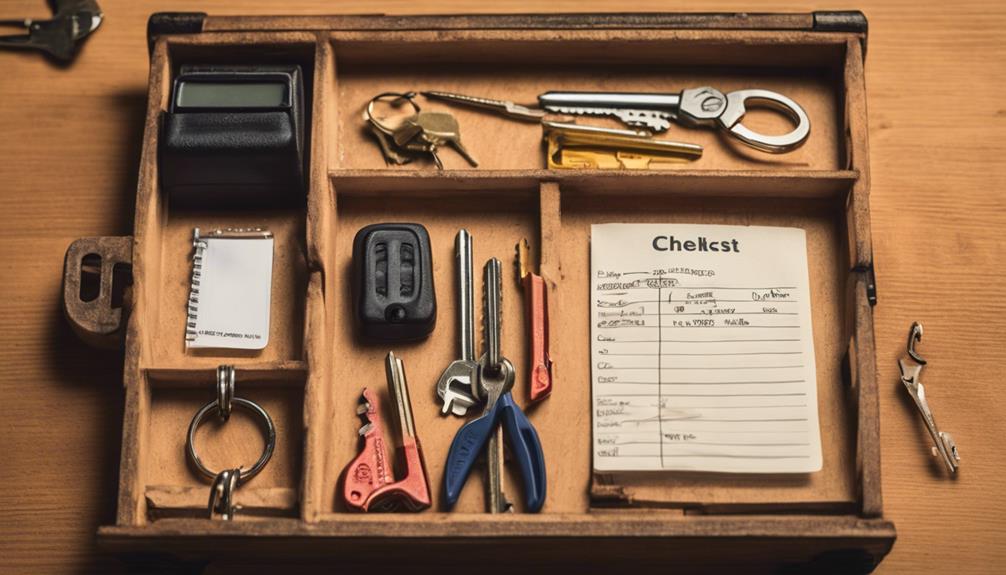
Maintaining your transponder key's functionality is key to avoiding future issues. First, regularly check your key's battery and replace it as needed. Weak batteries can cause intermittent failures, leaving you stranded. Next, practice key maintenance tips like keeping your key away from magnets and electronic devices that may interfere with its signal. Store your key in a protective case to prevent physical damage. Additionally, consider having alternative keys programmed as a backup. This guarantees you're never caught off guard if your primary key fails. Finally, consult your vehicle's manual or a professional for specific maintenance recommendations tailored to your transponder key. Proactive care gives you the power to avoid inconvenient breakdowns and guarantees smooth operation.




